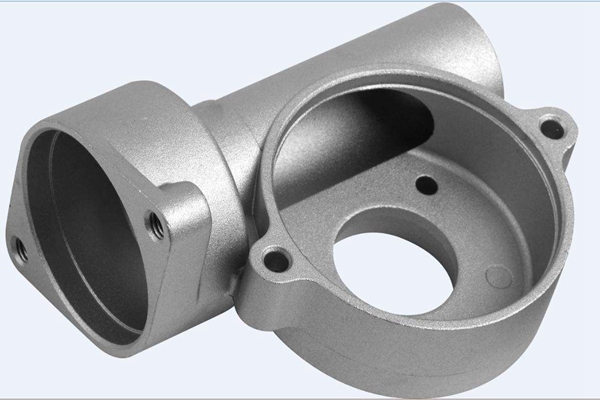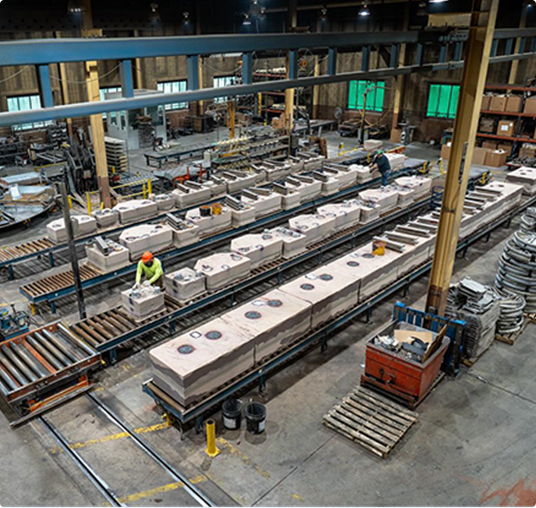Everything About Light Weight Aluminum Castings: Understanding Their Duty and Significance in Production
Aluminum castings are essential to modern production, offering a mix of lightweight buildings and toughness. They assist in complex designs while minimizing setting up expenses. Industries such as aerospace and automobile regularly use these components for enhanced efficiency. The production of aluminum spreadings is not without its obstacles. Understanding the subtleties of this process reveals both the advantages and prospective pitfalls. Checking out these variables will certainly provide much deeper insights right into their expanding significance.
Review of Light Weight Aluminum Spreading Processes
Light weight aluminum casting procedures play an important duty in production, using adaptability and performance. These processes entail pouring liquified aluminum right into mold and mildews to develop exact forms and components. Different techniques are utilized, including sand spreading, pass away casting, and investment spreading, each distinguished by its method of mold development and the desired application.
Sand casting uses a blend of sand and binder to form mold and mildews, permitting intricate geometries. Pass away spreading, on the other hand, includes requiring liquified aluminum into steel molds, leading to high precision and smooth surfaces. Investment spreading, frequently used for detailed designs, includes producing a wax pattern coated with a ceramic shell, which is then loaded with liquified light weight aluminum.
These casting methods satisfy diverse commercial requirements, making aluminum a preferred product for elements in fields such as automotive, aerospace, and customer items. The selection of casting technique considerably influences the end product's top quality and efficiency.
Advantages of Using Aluminum Castings
The benefits of using aluminum spreadings in manufacturing are substantial and countless. To start with, aluminum's lightweight nature adds to minimized total item weight, improving power performance in applications such as automotive and aerospace sectors. Additionally, light weight aluminum spreadings exhibit superb rust resistance, guaranteeing longevity and toughness in severe atmospheres. The product's electric and thermal conductivity also makes it appropriate for different applications, consisting of electronics and warm exchangers.
In addition, aluminum castings can be created with intricate layouts, enabling a lot more complicated forms that fulfill particular useful requirements. This flexibility adds to decreased setting up prices and enhanced layout versatility. Furthermore, the casting process itself is effective, enabling for high-volume production with constant quality. Aluminum is recyclable, making it an environmentally pleasant option in manufacturing. Collectively, these benefits highlight why light weight aluminum spreadings are significantly favored throughout varied markets, providing both performance benefits and economic effectiveness.
Typical Applications of Aluminum Castings
While various materials are made use of in manufacturing, light weight aluminum spreadings stand apart as a result of their broad variety of applications across multiple sectors. These spreadings are commonly used in the auto industry for engine parts, transmission real estates, and structural components, contributing to lighter automobiles and boosted fuel efficiency. In the aerospace sector, aluminum castings are critical for airplane components, where weight reduction is important for performance and safety and security.
Additionally, the electrical industry uses aluminum spreadings for housings and structural components in machinery, gaining from the product's outstanding conductivity. In customer products, aluminum castings can be discovered in things such as appliances and sporting devices, offering resilience and a contemporary aesthetic. Furthermore, the building market utilizes aluminum castings in building components, home window structures, and fixtures, showcasing their convenience and strength. In general, aluminum spreadings play an integral duty in improving product efficiency and efficiency throughout various industries.
Secret Production Techniques for Light Weight Aluminum Castings
The production of light weight aluminum spreadings counts on various techniques, with sand spreading and pass away spreading being among one of the most prominent. Sand casting includes creating molds from sand, enabling huge parts and detailed layouts. On the other hand, pass away casting uses high-pressure injection of liquified aluminum into recyclable mold and mildews, providing accuracy and efficiency for mass manufacturing.
Sand Spreading Process
Sand casting stands as one of one of the most widely utilized techniques for producing aluminum spreadings, many thanks to its convenience and cost-effectiveness. This process involves producing a mold from a mixture of sand and a bonding agent, typically clay. As soon as the mold and mildew is ready, molten aluminum is put into it, enabling the metal to fill up the tooth cavity. After cooling, the mold is broken away to reveal the casting. Sand spreading suits big parts and complicated geometries, making it appropriate for different applications. Furthermore, it permits very easy modifications, enabling manufacturers to change styles swiftly. The surface coating might need added machining for accurate applications, making sure the final product meets top quality criteria.
Pass Away Spreading Methods
Die casting stands for a very effective approach for generating aluminum castings, characterized by its capability to supply high precision and exceptional surface area coating. This strategy largely involves forcing molten aluminum right into a mold under high pressure, making sure that great information and detailed forms are captured precisely. There are two major die spreading approaches: warm chamber and cold chamber. Warm chamber pass away spreading is ideal for alloys with reduced melting factors and enables faster cycles, while cool chamber die casting is excellent for high-temperature alloys, calling for separate melting systems. Both techniques improve manufacturing rates and lower product waste, making die casting a preferred choice in industries such check over here as auto and electronics, where sturdiness and dimensional precision are extremely important.
Sustainability in Aluminum Casting Manufacturing
While the demand for aluminum spreadings remains to grow, manufacturers are significantly focusing on sustainability in their production procedures. This shift is driven by the requirement to decrease ecological impact and save all-natural sources. Lots of business are adopting reusing efforts, making use of scrap light weight aluminum, which significantly decreases power consumption and greenhouse gas discharges contrasted to key light weight aluminum manufacturing. In addition, developments in casting technologies why not try these out are enabling extra efficient use of products, minimizing waste during the manufacturing process.
Producers are likewise exploring environment-friendly alternatives to typical casting approaches, such as 3D printing and progressed mold innovations, which aid enhance resource usage. Wisconsin Aluminum Foundry. Furthermore, applying sustainable practices in supply chain management warranties that raw products are sourced properly. Because of this, the light weight aluminum spreading market is making strides toward a more lasting future, straightening with global ecological objectives while satisfying the boosting demand for high-performance aluminum items
Obstacles and Considerations in Aluminum Casting
Light weight aluminum casting presents different obstacles that producers have to navigate to ensure product integrity. Style complexity can make complex the casting procedure, resulting in prospective issues and enhanced production time. Additionally, maintaining rigorous high quality control criteria is important to fulfill the demands of precision and dependability in ended up components.

Style Complexity Issues
Designing parts for aluminum casting presents different complexities that engineers must navigate to achieve optimal outcomes. One substantial challenge is the need for precise geometry; elaborate layouts can bring about problems in mold and mildew creation and raised risk of defects. Furthermore, thermal buildings of aluminum demand Visit Website careful consideration of cooling rates, as uneven air conditioning can cause warping. Wall surface density variations likewise posture an obstacle, as they can affect flow qualities and structural integrity. Engineers should stabilize style visual appeals with manufacturability, guaranteeing that attributes such as ribs and fillets are enhanced for strength without making complex the spreading procedure. Factors to consider pertaining to draft angles are necessary to help with mold launch, more complicating the style procedure. These elements jointly highlight the details entailed in aluminum spreading design.
High Quality Control Difficulties
Attaining high-quality light weight aluminum spreadings involves maneuvering an array of quality assurance challenges that can significantly influence the last product. Initially, variants in raw material composition can result in incongruities in casting homes, making it necessary to assure material quality. Second, the casting process itself is susceptible to defects, such as porosity and shrinkage, which can jeopardize structural stability. Furthermore, temperature control throughout melting and pouring is important; variations can cause unequal solidification, impacting dimensional precision. Complete assessment approaches, including non-destructive testing, must be utilized to identify flaws early. Finally, preserving rigorous process paperwork and adherence to market standards is important for traceability and quality control, highlighting the detailed balance required to produce dependable light weight aluminum spreadings in manufacturing.
Future Trends in Light Weight Aluminum Spreading Technology
As suppliers venture to improve effectiveness and sustainability, technologies in aluminum spreading modern technology are emerging to satisfy these demands. One substantial trend is the assimilation of automation and man-made intelligence, which simplify production procedures and boost accuracy in casting procedures. These improvements decrease human error and optimize source usage, eventually resulting in cost decreases.
Additionally, the adoption of sophisticated products and alloys is improving the landscape. New solutions boost performance features, such as corrosion resistance and lightweight residential properties, making aluminum spreadings a lot more versatile across various markets.
In addition, lasting techniques are gaining grip, with a concentrate on recycling and lessening waste. Strategies such as 3D printing are likewise being explored to develop intricate geometries that were previously unattainable
Regularly Asked Questions

Just How Do Light Weight Aluminum Castings Compare to Various Other Materials?
Aluminum castings offer benefits such as lightweight, deterioration resistance, and exceptional thermal conductivity contrasted to various other products. They are usually chosen for applications requiring resilience and effectiveness, specifically in aerospace and auto markets.
What Is the Life-span of Light Weight Aluminum Castings?
The lifespan of light weight aluminum castings commonly ranges from 10 to 50 years, depending upon ecological conditions, use, and maintenance. Their deterioration resistance and durability add significantly to their long-lasting efficiency in numerous applications.
Can Aluminum Castings Be Recycled?
Yes, light weight aluminum castings can be reused. The recycling process is effective, enabling the recuperation of light weight aluminum without considerable loss of quality, making it a lasting selection in production and decreasing environmental effect.
What Precaution Are Needed Throughout Light Weight Aluminum Casting?
During aluminum casting, essential precaution consist of putting on appropriate individual safety tools, guaranteeing appropriate ventilation, preserving equipment, making use of fire-resistant materials, and carrying out safe dealing with protocols for molten metal to stop injuries and crashes.
How Do Temperature Modifications Influence Aluminum Castings?
Temperature changes markedly affect aluminum castings by influencing fluidness, solidification prices, and mechanical homes. Quick air conditioning can cause increased brittleness, while steady cooling promotes far better architectural honesty and decreases the danger of defects.
Die spreading, on the other hand, involves compeling liquified aluminum right into steel molds, resulting in high accuracy and smooth coatings. The production of light weight aluminum spreadings relies on numerous methods, with sand spreading and die casting being among the most popular. Sand casting stands as one of the most widely made use of techniques for producing light weight aluminum castings, many thanks to its convenience and cost-effectiveness. Die casting represents a very efficient method for creating aluminum spreadings, defined by its capability to deliver high accuracy and superb surface area coating. While the demand for light weight aluminum spreadings continues to grow, manufacturers are increasingly prioritizing sustainability in their production processes.